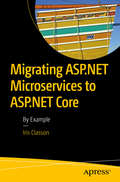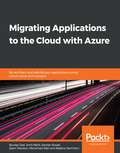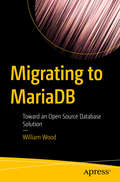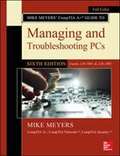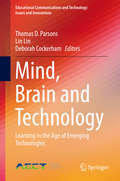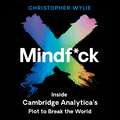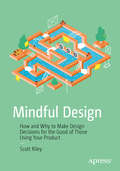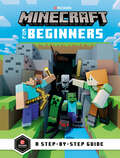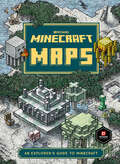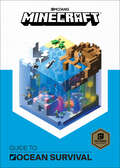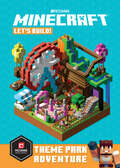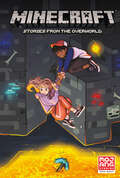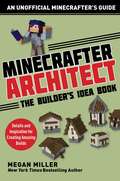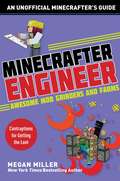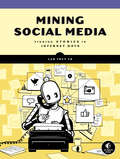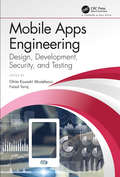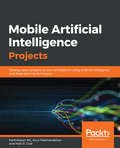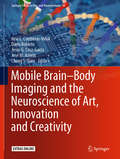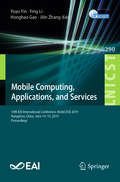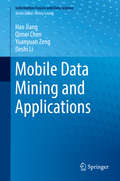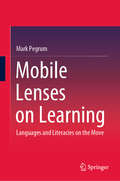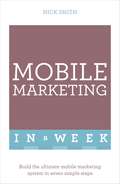- Table View
- List View
Migrating ASP.NET Microservices to ASP.NET Core: By Example
by Iris ClassonMigrate your existing microservice cluster from ASP .NET to ASP .NET Core. While improved performance and cross-platform support are evident, this book helps you cut through the noise to determine how, when, and to what extent a migration is needed.Microsoft’s introduction of .NET Core has created a lot of excitement, but also a lot of confusion for developers accustomed to ASP applications and services. This book gives you specific steps to embark on a partial or full SaaS microservices system migration, factoring in limited resources, time, and finances. In addition to practical advice and real-world examples, many mishaps will be shared, providing you with a complete 360-degree view of a migration.As a developer intimately familiar with the migration process, author Iris Classon shares prescriptive guidance on every part of the system—from code, dependencies, editors, integration, and the deployment pipeline to a distribution model. You will come away with all the information you need to plan and prepare your migration to ASP.NET Core.What You’ll LearnConduct an in-depth, pre-migration analysis of your system Know the differences between ASP .NET and ASP .NET CorePlan for and execute a full or partial migration to ASP .NET Core Understand the continuous integration and deployment process Gain insight on tools and templates that will accelerate and facilitate the migration processLeverage a real-world migration example, complete with genuine challengesMigrate specific components such as logging, authentication, data access, and moreWho This Book Is ForDevelopers who are considering or are tasked with migrating an existing microservice cluster from ASP.NET to ASP.NET Core. Experience with C#, Web API, ASP.NET, Visual Studio, and PowerShell is helpful.
Migrating Applications to the Cloud with Azure: Re-architect and rebuild your applications using cloud-native technologies
by Amit Malik Sander Rossel Sjoukje Zaal Mohamed Wali Jason MarstonModernize your apps with Microsoft Azure by moving web, desktop, and mobile apps to the cloud Key Features Decide which migration strategy is most suitable for your organization and create a migration roadmap Move existing infrastructure to Azure and learn strategies to reduce cost, increase storage, and improve ROI Design secure, scalable, and cost-effective solutions with the help of practical examples Book Description Whether you are trying to re-architect a legacy app or build a cloud-ready app from scratch, using the Azure ecosystem with .NET and Java technologies helps you to strategize and plan your app modernization process effectively. With this book, you'll learn how to modernize your applications by using Azure for containerization, DevOps, microservices, and serverless solutions to reduce development time and costs, while also making your applications robust, secure, and scalable. You will delve into improving application efficiency by using container services such as Azure Container Service, Azure Kubernetes Service (AKS), and more. Next, you will learn to modernize your application by implementing DevOps throughout your application development life cycle. You will then focus on increasing the scalability and performance of your overall application with microservices, before learning how to add extra functionality to your application with Azure serverless solutions. Finally, you'll get up to speed with monitoring and troubleshooting techniques. By the end of this book, you will have learned how to use the Azure ecosystem to refactor, re-architect, and rebuild your web, mobile, and desktop applications. What you will learn Use DevOps and containerization technologies to modernize your applications and infrastructure Build microservices using Azure Service Fabric Develop scalable applications using Azure Functions Manage and deploy your application code and database connectivity Secure and monitor your applications in Azure effectively Design for high availability and disaster recovery Who this book is for This book is for.NET and Java developers who want to modernize their applications using Azure. Solution architects and experienced developers interested in modernizing legacy applications using Azure will also find this book useful. Some prior understanding of cloud computing concepts will be beneficial.
Migrating to MariaDB: Toward An Open Source Database Solution
by William WoodMitigate the risks involved in migrating away from a proprietary database platform toward MariaDB’s open source database engine. This book will help you assess the risks and the work involved, and ensure a successful migration. Migrating to MariaDB describes the process and lessons learned during a migration from a proprietary database management engine to the MariaDB open source solution. The book discusses the drivers for making the decision and change, walking you through all aspects of the process from evaluating the licensing, navigating the pitfalls and hurdles of a migration, through to final implementation on the new platform. The book highlights the cost-effectiveness of MariaDB and how the licensing worries are simplified in comparison to running on a proprietary platform.You’ll learn to do your own risk assessment, to identify database and application code that may need to be modified or re-implemented, and to identify MariaDB features to provide the security and failover protection needed by corporate customers. Let the author’s experience in migrating a financial firm to MariaDB inform your own efforts, helping you to develop a road map for both technical and political success within your own organization as you migrate away from proprietary lock-in toward MariaDB’s open source solution. What You'll LearnEvaluate and compare licensing costs between proprietary databases and MariaDBPerform a proper risk assessment to inform your planning and execution of the migrationBuild a migration road map from the book’s example that is specific to your situationMake needed application changes and migrate data to the MariaDB open source database engineWho This Book Is ForTechnical professionals (including database administrators, programmers, and technical management) who are interested in migrating away from a proprietary database platform toward MariaDB’s open source database engine and need to assess the risks and the work involved
Mike Meyers' Comptia A+ Guide To Managing And Troubleshooting PCs ): (exams 220-1001 & 220-1002
by Mike MeyersFully Updated, Essential Skills for a Successful IT Career. Written by the leading authority on CompTIA A+ certification and training, this four-color guide will help you pass CompTIA A+ exams 220-1001 and 220-1002 and become a certified IT professional with proven expertise in hardware and software. Mike Meyers’ CompTIA A+® Guide to Managing and Troubleshooting PCs, Sixth Edition offers complete coverage of the latest exam objectives. You’ll get on-the-job tips, end-of-chapter review questions, and hundreds of photographs and illustrations. Learn how to: •Work with CPUs, RAM, BIOS, motherboards, power supplies, and other personal computer components•Install, configure, and maintain hard drives•Manage input devices and removable media•Set up, upgrade, and maintain all versions of Windows•Troubleshoot and fix computer problems•Establish users and groups•Set up video and multimedia cards•Administer smartphones, tablets, and other mobile devices•Set up wired and wireless networks•Connect to the Internet•Protect your personal computer and your network•Install printers and other peripherals•Implement virtualization and cloud-based technologies•Understand safety and environmental issues.
Mike Meyers' Comptia A+ Guide To Managing And Troubleshooting Pcs Lab Manual
by Mike Meyers Mark Edward SoperThis practical workbook contains more than 140 labs that challenge you to solve real-world problems by applying key concepts. Thoroughly revised for the 220-1001 and 200-1002 exam objectives, this book maps directly to Mike Meyers’ CompTIA A+® Guide to Managing and Troubleshooting PCs, Sixth Edition. You will get complete materials lists, setup instructions, and start-to-finish lab scenarios. “Hint” and “Warning” icons guide you through tricky situations, and post-lab questions measure your knowledge.
Mind, Brain and Technology: Learning in the Age of Emerging Technologies (Educational Communications and Technology: Issues and Innovations)
by Thomas D. Parsons Lin Lin Deborah CockerhamAs technology becomes increasingly integrated into our society, cultural expectations and needs are changing. Social understanding, family roles, organizational skills, and daily activities are all adapting to the demands of ever-present technology, causing changes in human brain, emotions, and behaviors. An understanding of the impact of technology upon our lives is essential if we are to adequately educate children for the future and plan for meaningful learning environments for them. Mind, Brain and Technology provides an overview of these changes from a wide variety of perspectives. Designed as a textbook for students in the fields and interdisciplinary areas of psychology, neuroscience, technology, computer science, and education, the book offers insights for researchers, professionals, educators, and anyone interested in learning more about the integration of mind, brain and technology in their lives. The book skilfully guides readers to explore alternatives, generate new ideas, and develop constructive plans both for their own lives and for future educational needs.
Mindf*ck: Inside Cambridge Analytica's Plot to Break the World
by AnonymousWhat if you could peer into the minds of an entire population? What if you could target the weakest with rumours that only they saw?In 2016, an obscure British military contractor turned the world upside down. Funded by a billionaire on a crusade to start his own far-right insurgency, Cambridge Analytica combined psychological research with private Facebook data to make an invisible weapon with the power to change what voters perceived as real.The firm was created to launch the then unknown Steve Bannon's ideological assault on America. But as it honed its dark arts in elections from Trinidad to Nigeria, 24-year-old research director Christopher Wylie began to see what he and his colleagues were unleashing.He had heard the disturbing visions of the investors. He saw what CEO Alexander Nix did behind closed doors. When Britain shocked the world by voting to leave the EU, Wylie realised it was time to expose his old associates. The political crime of the century had just taken place - the weapon had been tested - and nobody knew.
Mindful Design: How And Why To Make Design Decisions For The Good Of Those Using Your Product
by Scott RileyLearn to create seamless designs backed by a responsible understanding of the human mind. This book examines how human behavior can be used to integrate your product design into lifestyle, rather than interrupt it, and make decisions for the good of those that are using your product. Mindful Design introduces the areas of brain science that matter to designers, and passionately explains how those areas affect each human’s day-to-day experiences with products and interfaces. You will learn about the neurological aspects and limitations of human vision and perception; about our attachment to harmony and dissonance, such as visual harmony, musical harmony; and about our brain’s propensity towards pattern recognition and how we perceive the world cognitively. In the second half of the book you will focus on the practical application of what you have learned, specific to interaction and interface design. Real-world examples are used throughout so that you can really see how design is impacting our everyday digital experience. Design is a responsibility, but not enough designers understand the human mind or the process of thought. This book explores the key factors involved and shows you how to make the right design choices. What You'll Learn Review how attention and distraction work and the cost of attentional switchingUse Gestalt principles to communicate visual groupingEnsure your underlying models make sense to your audienceUse time, progression, and transition to create a compositionCarefully examine controlling behavior through reductionist and behaviorist motivation concepts Apply the theoretical knowledge to practical, mindful application design Who This Book Is For The primary audience for this book is professional designers who wish to learn more about the human mind and how to apply that to their work. The book is also useful for design-focussed product owners and startup founders who wish to apply ethical thinking to a team, or when bootstrapping their products. The secondary audience is design students who are either studying a ‘traditional’ visual design course, or a UX/interaction design course who have a desire to learn how they might be able to apply mindful design to their early careers. Finally, a tertiary audience for this book would be tutors involved in teaching design, or peripheral, courses who may wish to incorporate its teachings into their lectures, workshops or seminars.
Minecraft for Beginners (Minecraft)
by Mojang AB The Official Minecraft TeamCurious about Minecraft, but not sure where to start? This book is just what you need. With its open-ended game play, massive world and dedicated fan base, Minecraft is a richly rewarding experience—once you get the hang of it. With easy-to-follow instructions, tips and tricks from the experts behind the game, Minecraft for Beginners will help you survive and thrive. You&’ll learn how to find food, build a shelter, mine for materials and craft armor, swords and other equipment, plus get the inside scoop on places to go and the monsters you&’ll encounter. What are you waiting for? Begin your Minecraft adventure today! This ebook is best viewed on a color device with a larger screen.Collect all of the official Minecraft books:Minecraft: The IslandMinecraft: The CrashMinecraft: The Lost JournalsMinecraft: The Survivors&’ Book of SecretsMinecraft: Exploded Builds: Medieval FortressMinecraft: Guide to ExplorationMinecraft: Guide to CreativeMinecraft: Guide to the Nether & the EndMinecraft: Guide to RedstoneMinecraft: MobestiaryMinecraft: Guide to Enchantments & PotionsMinecraft: Guide to PVP MinigamesMinecraft: Guide to FarmingMinecraft: Let&’s Build! Theme Park AdventureMinecraft for Beginners
Minecraft: An Explorer's Guide to Minecraft (Minecraft)
by Mojang AB The Official Minecraft TeamDiscover the hidden corners of the many weird and wonderful locations in Minecraft with this beautifully illustrated, full-color guide--written in official partnership with the experts at game-creator Mojang.Are you ready for an adventure? Minecraft: Maps is a visual guide to the Minecraft landscape, created by an explorer on a quest to find the most valuable loot while avoiding danger. Explore each of the fifteen major biomes through highly detailed, illustrated maps, then read the explorer's notes about the unique features and discover an inspirational themed build idea for each.A beautifully illustrated visual guide in its own right, Minecraft: Maps is also a survival tool. You'll learn which biomes are home to the most dangerous mobs, where to look for exclusive blocks, how to find naturally generated structures and the best places to search for loot. Once you've discovered each biome you can get building--construct an ice palace in the ice plains biome and an entire village suspended in the tree canopy above the jungle floor.Biomes: Badlands, Dark Forest, Desert, Forest, Jungle, Mountains, Mushroom Fields, Ocean, Plains, Savanna, Snowy Tundra, Swamp, Taiga, The Nether, The End
Minecraft: Guide to Ocean Survival (Minecraft)
by Mojang AB The Official Minecraft TeamThe official Minecraft: Guide to Ocean Survival will teach you how to breathe underwater, find valuable sunken loot and fight off guardians and other menacing mobs of the deep.Minecraft&’s oceans are teeming with colorful life and rare treasures, but new dangers lurk beneath the water and survival can prove difficult. With insider info and tips from the experts at Mojang, this is the definitive guide to underwater survival.This ebook is best viewed on a color device with a larger screen.Collect all of the official Minecraft books:Minecraft: The IslandMinecraft: The CrashMinecraft: The Lost JournalsMinecraft: The Survivors&’ Book of SecretsMinecraft: Exploded Builds: Medieval FortressMinecraft: Guide to ExplorationMinecraft: Guide to CreativeMinecraft: Guide to the Nether & the EndMinecraft: Guide to RedstoneMinecraft: MobestiaryMinecraft: Guide to Enchantments & PotionsMinecraft: Guide to PVP MinigamesMinecraft: Guide to FarmingMinecraft: Let&’s Build! Theme Park AdventureMinecraft for BeginnersMinecraft: Guide to Ocean Survival
Minecraft: Let's Build! Land of Zombies (Minecraft)
by Mojang AB The Official Minecraft TeamHave you ever wanted to build an entire land dedicated to battling zombies? This guide will show you how it&’s done! Inside you&’ll find build ideas for everything from a zombie arena and a zombie-infested graveyard to an undead city and a top-secret lab where zombies are created and cured. Just follow the steps for each build, and before you know it you&’ll have an entire Land of Zombies to enjoy with your friends! This ebook is best viewed on a color device with a larger screen. Collect all of the official Minecraft books: Minecraft: The Island Minecraft: The Crash Minecraft: The Survivors&’ Book of Secrets Minecraft: Exploded Builds: Medieval Fortress Minecraft: Guide to Exploration Minecraft: Guide to Creative Minecraft: Guide to the Nether & the End Minecraft: Guide to Redstone Minecraft: Mobestiary Minecraft: Guide to Enchantments & Potions Minecraft: Guide to PVP Minigames Minecraft: Guide to Farming Minecraft: Let&’s Build! Theme Park AdventureMinecraft: Let&’s Build! Land of Zombies
Minecraft: Let's Build! Theme Park Adventure (Minecraft)
by Mojang AB The Official Minecraft TeamHave you ever wanted to build your very own theme park in Minecraft? This guide will show you how it&’s done! Inside you&’ll find build ideas for everything from a classic carousel and a haunted mansion ride to thrilling jungle river rapids and a terrifying alternate dimensions roller coaster. Just follow the steps for each build, and before you know it, you&’ll have an entire theme park to enjoy with your friends! This ebook is best viewed on a color device with a larger screen.Collect all of the official Minecraft books:Minecraft: The IslandMinecraft: The CrashMinecraft: The Lost JournalsMinecraft: The Survivors&’ Book of SecretsMinecraft: Exploded Builds: Medieval FortressMinecraft: Guide to ExplorationMinecraft: Guide to CreativeMinecraft: Guide to the Nether & the EndMinecraft: Guide to RedstoneMinecraft: MobestiaryMinecraft: Guide to Enchantments & PotionsMinecraft: Guide to PVP MinigamesMinecraft: Guide to FarmingMinecraft: Let&’s Build! Theme Park AdventureMinecraft for Beginners
Minecraft: Stories from the Overworld (Graphic Novel)
by Hope Larson Ian Flynn Stephen McCranie Rafer RobertsFrom blocks to panels! Minecraft returns to comics in this stand-alone anthology collection of officially licensed, original comic stories!With tales of witch and pillager rivals finding common ground, a heartless griefer who bit off more than they could chew, and valiant heroes new (or not!) to the Overworld, this anthology tells tales that span the world of Minecraft. Featuring stories from star writers Hope Larson (Batgirl), Kevin Panetta (Zodiac Starforce, Bloom), Rafer Roberts (Modern Fantasy, Grumble), and Ian Flynn (Sonic, Mega Man) and exciting artists Meredith Gran (Octopus Pie) and more, this collection brings together stories from all realms, leaving no block unturned!
Minecrafter Architect: Details and Inspiration for Creating Amazing Builds (Architecture for Minecrafters)
by Megan MillerBecome a Master Builder of Structures! <P><P>Tired of the same old 9x9 cobblestone cubes? Stuck figuring out what type of windows to add to your mansion? Minecrafter Architect: The Builder’s Idea Book will solve your builder’s block, with dozens of examples of window treatments, entranceways, roofs, walls, paths, road, bridges, floorplans, block palettes, and more. Copy them exactly or use them as inspiration, and you’ll be mastering the art of creating unique and detailed Minecraft builds. <P><P>Guided by hundreds of in-game, step-by-step photos and simple instructions, kids will learn how to add excitement, artistry, and variety to everything they build. Perfect for beginner to advanced Minecrafters who want to learn more Includes hundreds of step-by-step, full-color photos to guide readers of all ages <br>Helps encourage creativity and problem-solving skills <P><P>Minecrafter Architect: The Builder’s Idea Book appeals to the virtual artist in every gamer and holds the valuable secrets players need to stretch their building skills.
Minecrafter Engineer: Contraptions for Getting the Loot (Engineering for Minecrafters)
by Megan MillerYou have your farms of cactus, wheat, melons, and sugarcane. You have some decent armor and a nice base. Now you need more. More blaze rods, more iron, more wither skeleton skulls, more gunpowder, more enchanted books, more everything! <P><P>Minecrafter Engineer: Incredible Mob Grinders teaches kids how to build the incredible mob farms the experts use to increase their wealth and loot, from the witch farm to the iron golem trap. <P><P>The Minecraft Engineer series is designed to encourage creativity and problem-solving skills in kids who love building in Minecraft. <P><P>Each book helps players work within the physics of the game to build clever contraptions that add to their gaming experience. Guided by hundreds of in-game, step-by-step photos and simple instructions, kids will learn how to engineer one of many incredible mob grinders to yield resources and goodies beyond their wildest dreams. (Hundreds of chests to hold your booty not included.) <P><P>Perfect for beginner to advanced Minecrafters who want to learn more <P><P>Includes hundreds of step-by-step, full-color photos to guide readers of all ages <P><P>Helps encourage creativity and problem-solving skills <P><P>You’re not an expert gamer until you learn the tricks and tips in this book! <P><P>Minecrafter Engineer holds the valuable secrets to becoming the Minecrafter engineer you’ve always wanted to be.
Mining Social Media: Finding Stories in Internet Data
by Lam Thuy VoBuzzFeed News Senior Reporter Lam Thuy Vo explains how to mine, process, and analyze data from the social web in meaningful ways with the Python programming language.Did fake Twitter accounts help sway a presidential election? What can Facebook and Reddit archives tell us about human behavior? In Mining Social Media, senior BuzzFeed reporter Lam Thuy Vo shows you how to use Python and key data analysis tools to find the stories buried in social media.Whether you're a professional journalist, an academic researcher, or a citizen investigator, you'll learn how to use technical tools to collect and analyze data from social media sources to build compelling, data-driven stories.Learn how to: • Write Python scripts and use APIs to gather data from the social web • Download data archives and dig through them for insights • Inspect HTML downloaded from websites for useful content • Format, aggregate, sort, and filter your collected data using Google Sheets • Create data visualizations to illustrate your discoveries • Perform advanced data analysis using Python, Jupyter Notebooks, and the pandas library • Apply what you've learned to research topics on your ownSocial media is filled with thousands of hidden stories just waiting to be told. Learn to use the data-sleuthing tools that professionals use to write your own data-driven stories.
Mob School Swap: The Creeper Diaries, An Unofficial Minecrafters Novel, Book Eight (The Creeper Diaries #8)
by Greyson MannWhen Mom decides the Creeper family should take part in a student-exchange program, Gerald knows his house is going to get a lot more crowded. But he's horrified when the mob they're hosting turns out to be human. Now Gerald has to bring his new "brother" to school with him. But how can a creeper be cool showing up at Mob Middle School with a human at his side? Gerald is sure this is going to be his longest semester ever. Can he make the best of it, or will it all end in a blast of embarrassment?
Mobile Apps Engineering: Design, Development, Security, and Testing
by Ghita Kouadri Mostefaoui and Faisal TariqThe objective of this edited book is to gather best practices in the development and management of mobile apps projects. Mobile Apps Engineering aims to provide software engineering lecturers, students and researchers of mobile computing a starting point for developing successful mobile apps. To achieve these objectives, the book’s contributors emphasize the essential concepts of the field, such as apps design, testing and security, with the intention of offering a compact, self-contained book which shall stimulate further research interest in the topic. The editors hope and believe that their efforts in bringing this book together can make mobile apps engineering an independent discipline inspired by traditional software engineering, but taking into account the new challenges posed by mobile computing.
Mobile Artificial Intelligence Projects: Develop Seven Projects On Your Smartphone Using Artificial Intelligence And Deep Learning Techniques
by Arun PadmanabhanThis book is for machine learning professionals, deep learning engineers, AI engineers, software engineers who want to integrate AI technology into mobile-based platforms and applications. Sound knowledge of machine learning and experience with any of the programming language is all you need to get started with this book.
Mobile Brain-Body Imaging and the Neuroscience of Art, Innovation and Creativity (Springer Series on Bio- and Neurosystems #10)
by Jose L. Contreras-Vidal Chang S. Nam Dario Robleto Jesus G. Cruz-Garza José M. AzorínMobile Brain–Body Imaging and the Neuroscience of Art, Innovation and Creativity is a trans-disciplinary, collective, multimedia collaboration that critically uncovers the challenges and opportunities for transformational and innovative research and performance at the nexus of art, science and engineering. This book addresses a set of universal and timeless questions with a profound impact on the human condition: How do the creative arts and aesthetic experiences engage the brain and mind and promote innovation?How do arts–science collaborations employ aesthetics as a means of problem-solving and thereby create meaning?How can the creative arts and neuroscience advance understanding of individuality and social cognition, improve health and promote life-long learning?How are neurotechnologies changing science and artistic expression?How are the arts and citizen science innovating neuroscience studies, informal learning and outreach in the public sphere?Emerging from the 2016 and 2017 International Conferences on Mobile Brain–Body Imaging and the Neuroscience of Art, Innovation and Creativity held in Cancun, Mexico and Valencia, Spain to explore these topics, this book intertwines disciplines and investigates not only their individual products—art and data—but also something more substantive and unique; the international pool of contributors reveals something larger about humanity by revealing the state of the art in collaboration between arts and sciences and providing an investigational roadmap projected from recent advances.Mobile Brain–Body Imaging and the Neuroscience of Art, Innovation and Creativity is written for academic researchers, professionals working in industrial and clinical centers, independent researchers and artists from the performing arts, and other readers interested in understanding emergent innovations at the nexus of art, science, engineering, medicine and the humanities. The book contains language, design features (illustrations, diagrams) to develop a conversational bridge between the disciplines involved supplemented by access to video, artistic presentations and the results of a hackathon from the MoBI conferences.
Mobile Computing, Applications, and Services: 10th EAI International Conference, MobiCASE 2019, Hangzhou, China, June 14–15, 2019, Proceedings (Lecture Notes of the Institute for Computer Sciences, Social Informatics and Telecommunications Engineering #290)
by Ying Li Honghao Gao Yuyu Yin Jilin ZhangThis book constitutes the thoroughly refereed post-conference proceedings of the 10th International Conference on Mobile Computing, Applications, and Services, MobiCASE 2019, held in Hangzhou, China, in June 2019. The 17 full papers were carefully reviewed and selected from 48 submissions. The papers are organized in topical sections on mobile application with data analysis, mobile application with AI, edge computing, energy optimization and application
Mobile Data Mining and Applications (Information Fusion and Data Science)
by Hao Jiang Qimei Chen Yuanyuan Zeng Deshi LiThis book focuses on mobile data and its applications in the wireless networks of the future. Several topics form the basis of discussion, from a mobile data mining platform for collecting mobile data, to mobile data processing, and mobile feature discovery. Usage of mobile data mining is addressed in the context of three applications: wireless communication optimization, applications of mobile data mining on the cellular networks of the future, and how mobile data shapes future cities. In the discussion of wireless communication optimization, both licensed and unlicensed spectra are exploited. Advanced topics include mobile offloading, resource sharing, user association, network selection and network coexistence. Mathematical tools, such as traditional convexappl/non-convex, stochastic processing and game theory are used to find objective solutions. Discussion of the applications of mobile data mining to cellular networks of the future includes topics such as green communication networks, 5G networks, and studies of the problems of cell zooming, power control, sleep/wake, and energy saving. The discussion of mobile data mining in the context of smart cities of the future covers applications in urban planning and environmental monitoring: the technologies of deep learning, neural networks, complex networks, and network embedded data mining. Mobile Data Mining and Applications will be of interest to wireless operators, companies, governments as well as interested end users.
Mobile Lenses on Learning: Languages and Literacies on the Move
by Mark PegrumThis book explores mobile learning as a form of learning particularly suited to our ever more mobile world, presenting a new conceptualisation of the value of mobile devices in education through the metaphor of lenses on learning. With a principal focus on mobile-assisted language learning (MALL), it draws on insights derived from MALL language, literacy and cultural projects to illustrate the possibilities inherent in all mobile learning.In its broad sweep the book takes in new and emerging technologies and tools from robots to holograms, virtual reality to augmented reality, and smart glasses to embeddable chips, considering their potential impact on education and, indeed, on human society and the planet as a whole. While not shying away from discussing the risks, it demonstrates that, handled appropriately, mobile, context-aware technologies allow educators to build on the personalised and collaborative learning facilitated by web 2.0 and social media, but simultaneously to go much further in promoting authentic learning experiences grounded in real-world encounters. In this way, teachers can better prepare students to face a global, mobile future, with all of its evolving possibilities and challenges.
Mobile Marketing In A Week: Build The Ultimate Mobile Marketing System In Seven Simple Steps
by Nick SmithUnderstand mobile marketing fast, without cutting cornersAn understanding of mobile marketing is essential for anyone who wants to reach the growing market of on-the-go consumers. In this short, accessible book, Nick Smith shares a lifetime of hard-earned wisdom and practical advice, giving you, in straightforward language, all the mobile marketing expertise you need to run successful mobile campaigns. The 'in a week' structure explains the essentials of mobile marketing over just 7 days:Sunday: Why the future is mobileMonday: Basic mobile traffic getting tacticsTuesday: Social mobile marketingWednesday: Mobile pay per click (PPC) marketingThursday: Mobile apps for SMEsFriday: SMS marketingSaturday: Building the ultimate mobile marketing systemAt the end there are questions to ensure you have taken it all in and cartoons, diagrams and visual aids throughout help make Mobile Marketing In A Week an enjoyable and effective learning experience.So what are you waiting for? Take the fast track to successful mobile marketing!
